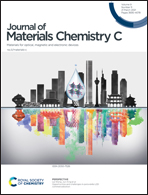Fabricating ultra-flexible photodetectors at the neutral mechanical plane by encapsulation†
Abstract
The center plane inside a bending material has no strain, which is known as the neutral mechanical plane. Based on this concept, herein, we achieve ultra-flexible semiconductor film-based photodetectors at the neutral mechanical plane sandwiched by two polyethylene terephthalate (PET) layers. With this design, the as-fabricated encapsulated semiconductor film-based photodetectors are measured to work stably with the outside surface under a large strain up to 10%, which is two orders of magnitude larger than what the counterpart on the outside surface can bear. Actually, the encapsulated photodetectors are supposed to perform stably during the bending process no matter how large the strain of the outside surface is, as long as the substrate can be bent to the target bending curvature. Meanwhile, they show an ultra-stable performance with almost unvaried photoresponse properties after 10 000 bending cycles or a bending duration of 1000 h with the radius of curvature of 5 mm. Furthermore, they can work as long-term stable rollable photodetectors, which are rarely reported. It can be expected that this structure design will greatly push forward the research and application of flexible photodetectors, especially for those based on brittle photosensitive materials.



 Please wait while we load your content...
Please wait while we load your content...